The Ultimate Guide to Dopamine Decor for a Joy-Filled Home
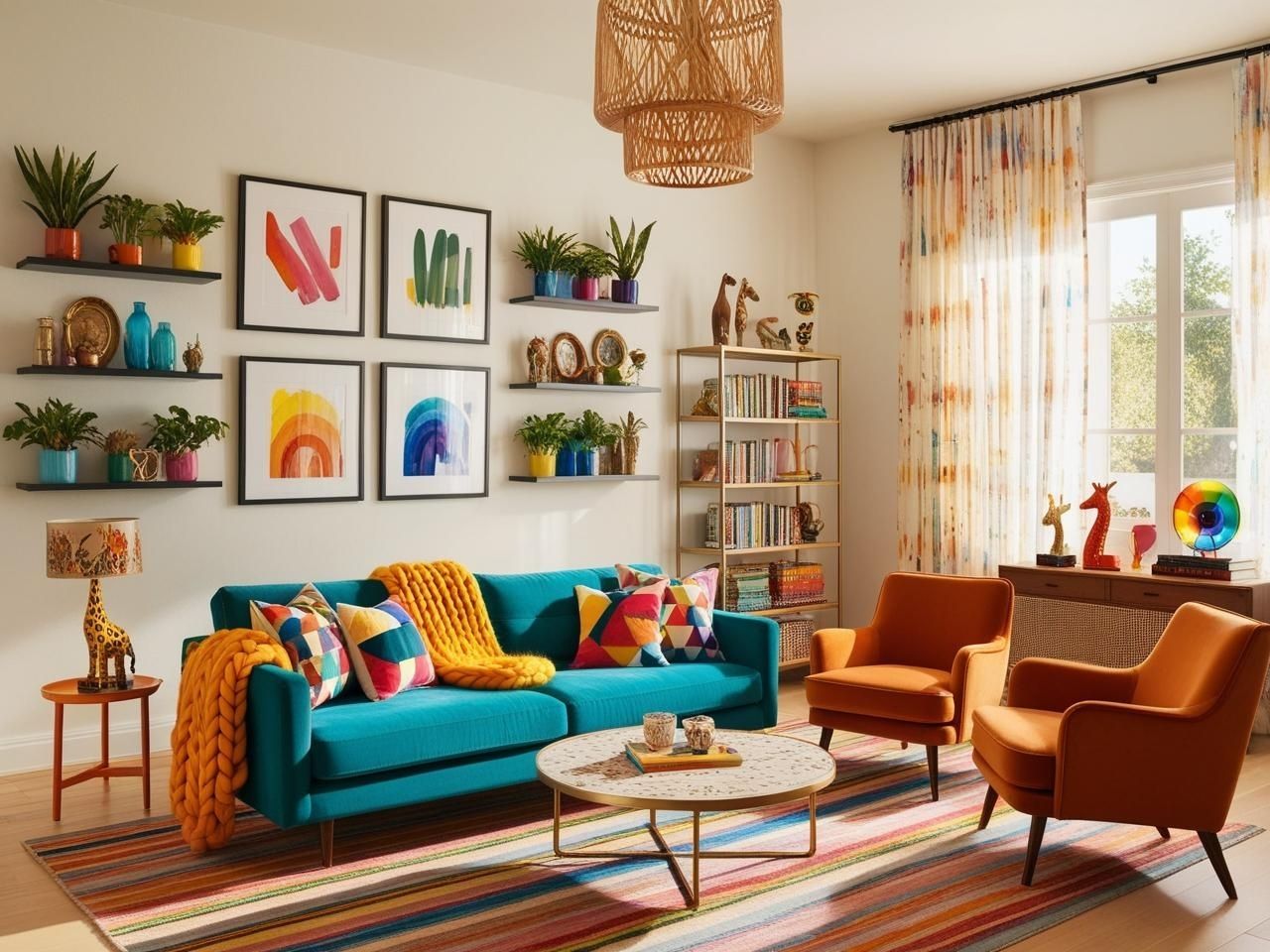
Let’s be honest—we’ve all had that moment. You walk into a space, and something just clicks. Your shoulders drop an inch, the corners of your mouth twitch upward, and suddenly everything feels a little bit better. That’s not just good design luck—that’s your brain on dopamine, baby.
Welcome to the world of dopamine decor, where we’re not trying to create perfectly curated showrooms that nobody actually lives in. This is about designing spaces that make your brain do a little happy dance every time you walk through the door.
Forget those ultra-serious design manifestos that treat wall colors like philosophical decisions with life-or-death consequences. We’re taking a different approach. Think of this as the design equivalent of that friend who brings excellent wine to dinner parties but still laughs at fart jokes. Knowledgeable? Absolutely. Taking itself too seriously? Not a chance.
Dopamine decor isn’t about following rigid rules or buying specific products. It’s about understanding the fundamental truth that your environment affects your brain chemistry—and then using that knowledge to create spaces that genuinely make you feel good. Not spaces that look impressive on Instagram. Not spaces that follow this year’s trends. Spaces that hit your personal joy buttons in all the right ways.
Whether you’re working with a shoebox apartment or a sprawling house, an IKEA budget or a trust fund, dopamine decor principles can transform how you experience your daily life. Because ultimately, that’s what this is all about—creating a home that actively contributes to your well-being instead of just being a neutral backdrop to your existence.
Ready to make your space work for your brain instead of against it? Let’s dive into the world of dopamine decor—no prescription required.
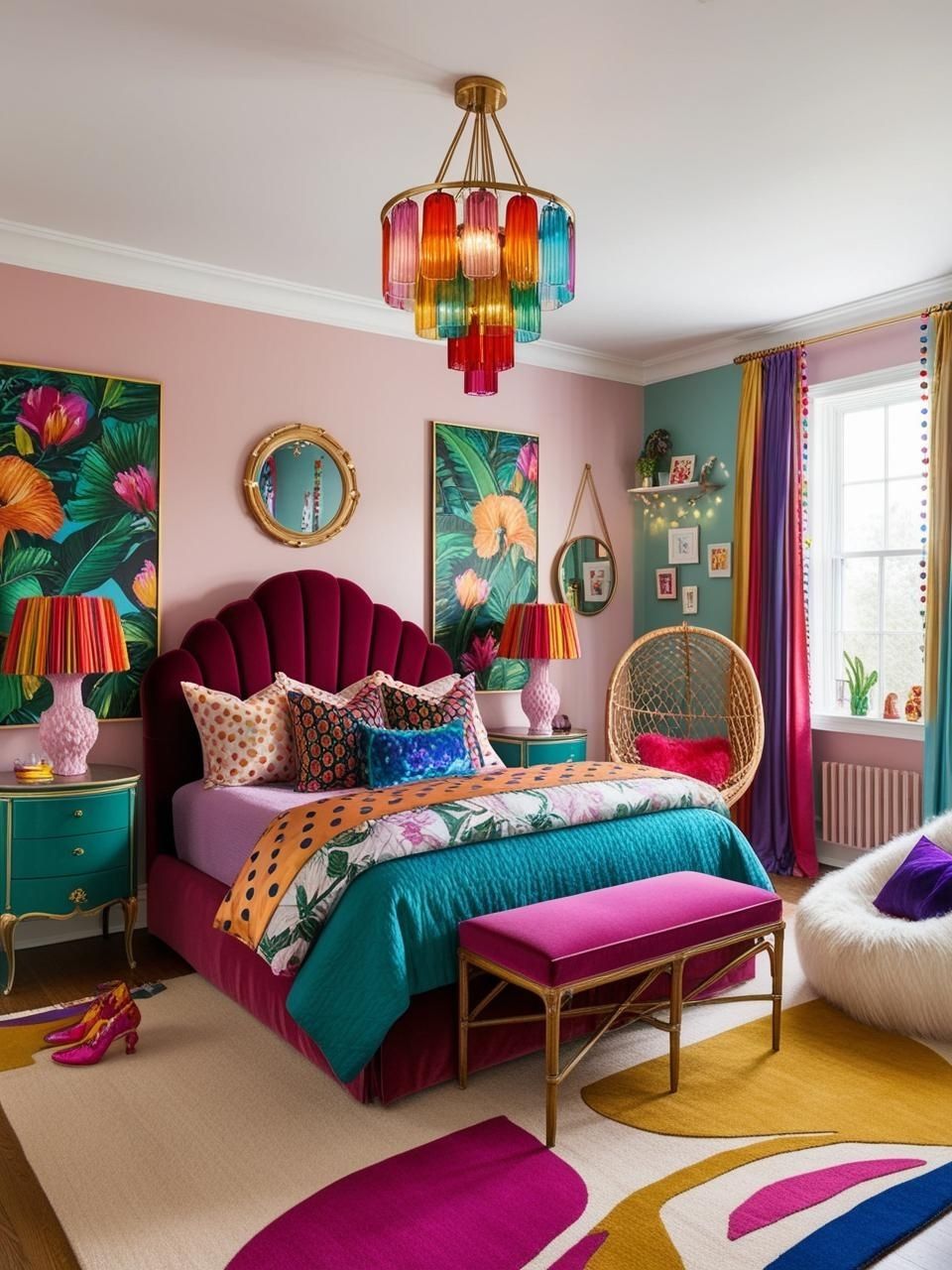
What is Dopamine Decor?
Let’s talk about the rooms that make you feel something the moment you walk in. We’re not talking about the sterile showroom setups that look perfect but feel like no one actually lives there. Dopamine decor is the opposite of that manufactured perfection—it’s about spaces that hit you with a jolt of genuine joy.
The Feel-Good Factor
Dopamine decor isn’t just another buzzy trend label slapped on by marketers. There’s actual science behind why certain spaces make your brain do a little happy dance. When your environment includes elements that personally delight you, your brain responds with a hit of dopamine—that’s the neurotransmitter responsible for that warm fuzzy feeling when something goes right.
The beauty here? You don’t need a designer’s budget or a psychology degree to make it work. You just need to be honest about what actually makes you happy, not what’s supposed to make you happy.
What Makes It Work
After experimenting with countless spaces, I’ve noticed the dopamine-boosting environments share a few key characteristics:
- Bold color choices: Not necessarily neon everything, but intentional pops of hues that energize rather than exhaust
- Pattern play: Visual interest that catches your eye and keeps it entertained
- Personal significance: Items that tell stories you actually care about, not generic “live laugh love” platitudes
- Textural contrasts: Surfaces that invite touch and create sensory richness
Not Your Average “Happy Home” Concept
The dopamine approach diverges from traditional design wisdom in one crucial way—it prioritizes your emotional response over rigid style rules. While minimalism asks “what can I remove?”, dopamine decor asks “what makes me feel good?”
I’ve seen people transform lackluster rooms simply by introducing elements that spark genuine connection. A vintage record player that brings music back into daily life. A reading nook bathed in natural light with pillows in exactly the right shade of peacock blue. A gallery wall featuring actual adventures, not stock photos of places you’ve never been.
These spaces work because they’re authentic. They don’t look “finished” in the staged-home sense—they look alive.
Beyond the Aesthetic Buzz
Here’s where dopamine decor gets really interesting: it’s not just about the instant visual hit. The science behind dopamine reveals it’s tied to anticipation and reward pathways. That’s why the most successful dopamine-filled spaces incorporate elements of discovery—shelves with objects that reveal themselves gradually, lighting that shifts throughout the day, or textiles that feel different than they look.
Let me tell you about a living room I worked on that went from “perfectly fine” to “can’t stop smiling” territory. The homeowner had everything “right”—the proportions, the color scheme, even tasteful art. But it felt like a nice hotel lobby, not a place where actual living happened. We ditched the forgettable coffee table books and brought in a collection of board games in vintage boxes that doubled as conversation pieces. We swapped out the requisite fiddle leaf fig (honestly, the most overworked plant in design) for a dramatic monstera that created shadows like art installations when the afternoon light hit.
The result? A space that demanded interaction rather than polite appreciation. And that’s really the essence of dopamine decor—it’s active, not passive. It asks you to engage, to touch, to notice, to experience. It’s the design equivalent of a witty friend rather than a formal acquaintance.
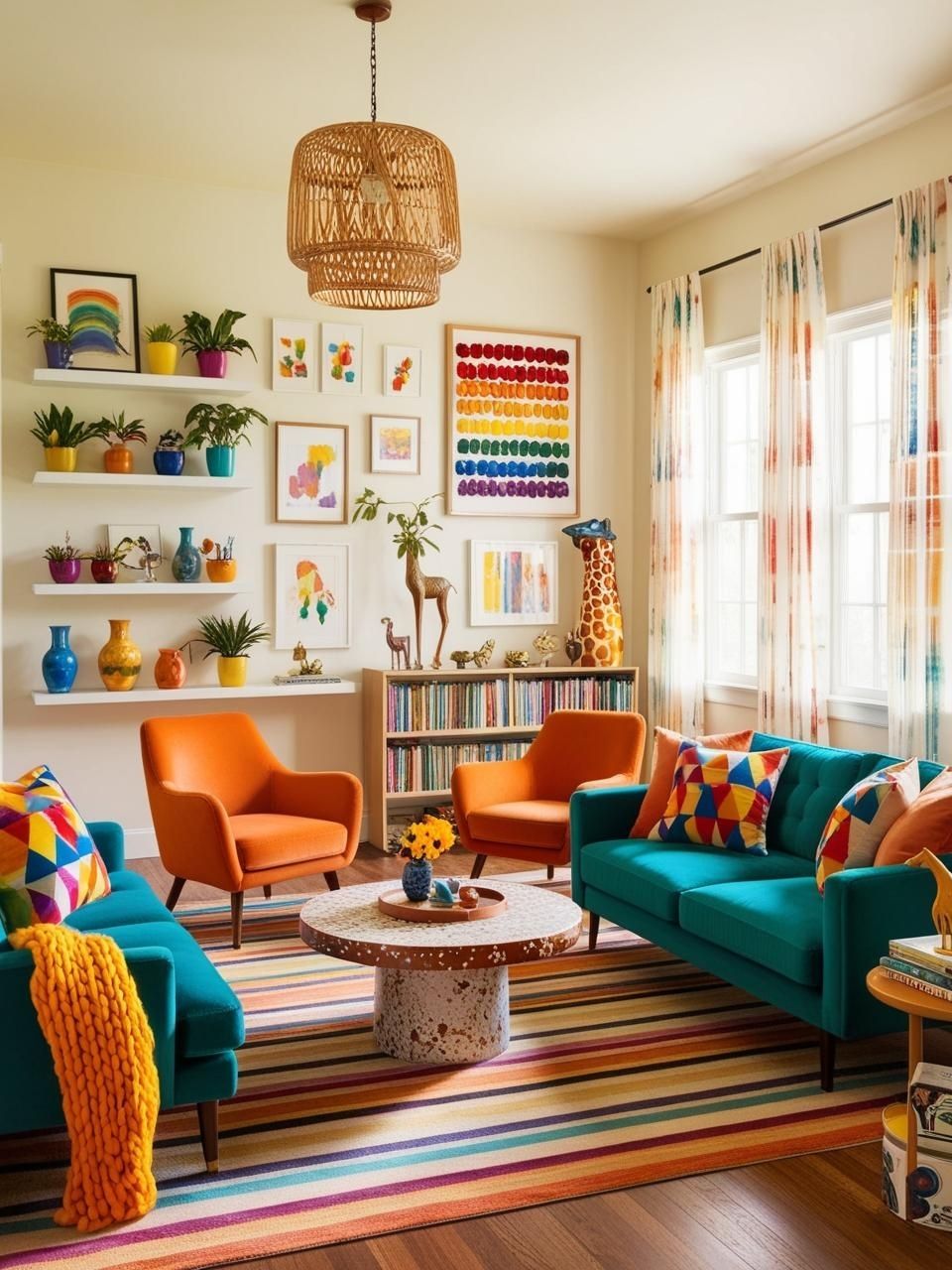
Step 1 – Use Color to Boost Your Mood
Let’s be honest—color is the gateway drug of dopamine decor. Nothing transforms a space faster than paint, and nothing signals your brain to wake up and pay attention quite like the right hue. But here’s the part most color guides won’t tell you: those “happy colors” aren’t one-size-fits-all.
The Color Truth Bomb
That sunshine yellow that’s supposed to be universally uplifting? It might make you feel like you’re trapped in a cartoon nightmare if yellow isn’t your thing. The dopamine approach isn’t about following prescriptive color rules—it’s about identifying which colors actually make you feel something.
I once worked with a client who insisted they wanted an all-neutral space because design magazines told them it was “timeless.” After some digging, I discovered they had childhood memories of a turquoise kitchen where their grandmother made pancakes every Sunday. Guess what color ended up on their kitchen island? The smile when they walked in was worth breaking every neutral-loving designer’s rulebook.
Strategic Color Placement
Here’s where strategy comes in. You don’t need to paint every wall electric blue to get the dopamine hit. Consider these approaches:
- The unexpected pop: A bright yellow inside a bookshelf or cabinet interior that reveals itself only when opened
- The grounding base: Rich, saturated colors like emerald green or navy blue that anchor a space while allowing brighter accents to dance around them
- The color block: Geometric shapes of bold color on an otherwise neutral wall—less commitment, maximum impact
- The colorful functional: Appliances, furniture pieces, or textiles in vibrant hues that serve double-duty as both useful items and mood boosters
The Psychology Without the Preaching
Yes, color psychology is real. No, you don’t need to memorize a textbook about it. The short version:
- Reds and oranges: Energizing, appetite-stimulating, conversation-starting
- Yellows: Optimistic, attention-grabbing (use with intention—a little goes a long way)
- Blues: Calming, focus-enhancing, sleep-promoting (perfect for bedrooms)
- Greens: Balancing, nature-connecting, stress-reducing
But here’s the real secret—personal association trumps general psychology every time. If mustard yellow reminds you of your ex’s horrible couch, no amount of “it’s energizing!” will make it work for you.
The Unexpected Color Champions
The most interesting dopamine-inducing spaces often incorporate colors that don’t get enough love in mainstream design:
- Terracotta: That earthy orange-brown that feels both ancient and completely contemporary
- Jewel-toned teals: Not quite blue, not quite green, entirely captivating
- Dusty plums: Purple without the Barney vibes
- Chartreuse: The zesty yellow-green that makes neutral rooms suddenly wake up
Remember, the goal isn’t creating a rainbow explosion (unless that’s your jam). It’s about identifying which colors genuinely make your space feel more alive, more you, and more joyful. And sometimes that means breaking every color “rule” you’ve ever heard.
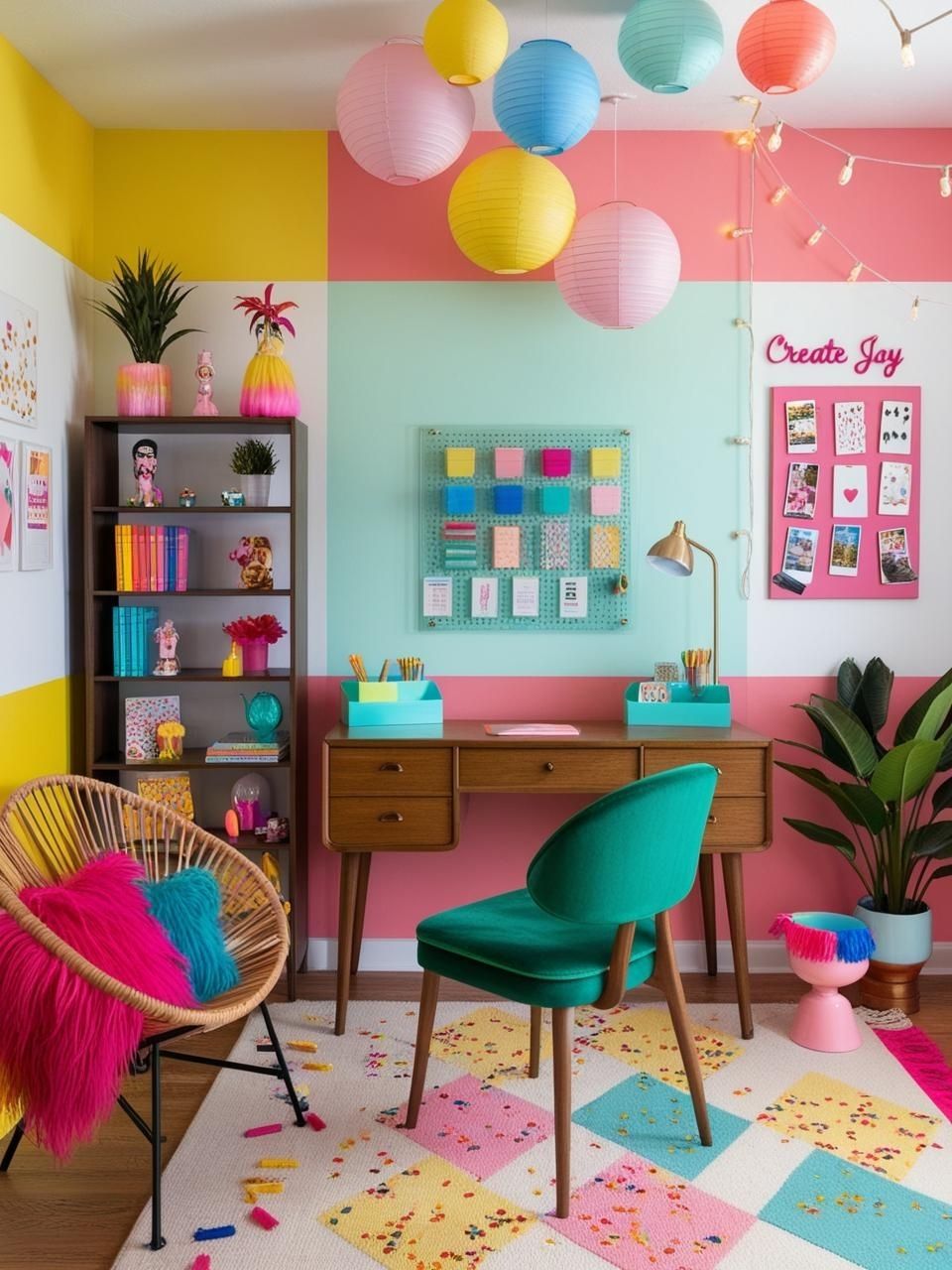
Step 2 – Infuse Playful Patterns and Textures
If color is the gateway drug to dopamine decor, patterns and textures are where you develop a full-blown design addiction. Let’s be clear—we’re not talking about slapping some polka dots on a throw pillow and calling it a day. This is about creating spaces with visual rhythm and tactile interest that keep your brain happily engaged.
Pattern Play That Doesn’t Make Your Eyes Hurt
Listen, there’s a fine line between “visually stimulating” and “might trigger a migraine.” The secret to pattern success isn’t about maximum intensity—it’s about intentional contrast.
I once walked into a room where the owner had enthusiastically embraced patterns… everywhere. Floral wallpaper, striped curtains, geometric rug, plaid sofa—it was like every pattern in design history was having a shouting match. We kept the wallpaper (gorgeous) and the rug (expensive) but dialed everything else back. The result? The patterns actually got to shine instead of fighting for attention like toddlers at a birthday party.
Here’s how to make patterns work for your dopamine hit:
- Scale variation: Mix large-scale patterns with small-scale ones—the contrast creates visual interest without chaos
- Pattern personality: Geometrics feel modern and orderly; florals add organic softness; abstract patterns bring dynamic energy
- Background/foreground play: Let some patterns take center stage while others act as supporting characters
The Texture Truth No One Talks About
Here’s the dirty little secret about texture: it’s actually more important than pattern for creating a space that feels good. You can have a room with zero patterns that still delivers major dopamine points through texture alone.
Think about running your hand across:
- A nubby bouclé sofa that feels like petting a friendly sheep
- The cool, smooth surface of a marble side table
- The satisfying weight of a chunky knit throw
These tactile experiences trigger sensory pleasure that visual stimulation alone can’t match. In a world where we spend our days tapping glass screens, texture brings us back to our physical reality.
Texture Layering 101
Creating a texture-rich environment isn’t about maxing out your credit card at West Elm. It’s about thoughtful layering:
- Contrast is king: Pair smooth with rough, matte with glossy, soft with hard
- Unexpected texture bombs: A rough-hewn wooden box on a sleek console, a fuzzy pillow on a leather chair
- Texture zoning: Create areas of textural intensity (that reading nook with the velvet chair) and areas of textural calm (the clean-lined dining area)
I worked with a space where everything was visually perfect but felt emotionally flat. The solution wasn’t more color or pattern—it was texture. We brought in a chunky jute rug, swapped out slick photo frames for ones with more substantial presence, and added a collection of ceramics with interesting glazes. Suddenly, the space felt alive.
When Patterns and Textures Collide (in a Good Way)
The dopamine sweet spot often happens at the intersection of pattern and texture. A geometric pattern that’s also embossed. A floral design rendered in velvet. A subtle herringbone with just enough dimension to catch the light.
These combinations deliver a one-two punch of visual and tactile stimulation that keeps spaces interesting long after the initial “wow” factor fades.
Remember, the goal isn’t creating sensory overload—it’s creating sensory engagement. Your space should invite touch, reward close inspection, and reveal itself gradually. Because that’s the thing about dopamine—it’s not just about the immediate hit, it’s about the sustained pleasure of discovery.
Your Shortcut to Effortless Mid-Century Modern Style
12 refined color palettes & implementation strategies designed to bring sophistication, texture, and harmony into your home.

Step 3 – Add Personal Touches for Emotional Connection
Let’s cut through the fluff: the most dopamine-inducing spaces aren’t the ones that look like they belong in a magazine spread – they’re the ones that actually make you feel something. And nothing triggers that feel-good brain chemistry like surrounding yourself with items that have genuine personal significance.
The Memory Lane That Doesn’t Look Like a Hoarder’s Paradise
We’ve all been in spaces that feel like emotional yard sales – every knick-knack ever collected, displayed with all the organization of a toddler’s toy box. That’s not what we’re after. The trick to personal decor that doesn’t look like chaos is curation with intention.
I once worked with someone who had amassed a collection of concert ticket stubs spanning two decades. Instead of letting them yellow in a shoebox, we created a simple shadow box display – not everything made the cut, but the ones that did told a story of pivotal musical moments. The result? A genuine conversation piece that delivered a dopamine hit every time they glanced at it.
Your strategy for personal items:
- Curate ruthlessly: If it doesn’t spark genuine joy or meaningful memories, it’s just clutter with sentimental pretensions
- Group like things: Collections gain power when displayed together rather than scattered randomly
- Create hierarchy: Not everything meaningful deserves prime real estate – rotate pieces seasonally if you have too many
Beyond the Basic Gallery Wall
Let’s talk about the elephant in the design room: family photos. Here’s your permission slip to break free from the tyranny of the basic gallery wall. Those grid-perfect arrangements of matching frames? About as exciting as oatmeal without toppings.
Try these dopamine-boosting alternatives:
- The salon hang: Mix photos with art, varying frame styles and sizes for visual interest
- The unexpected location: Family photos in the kitchen or bathroom, where they’ll actually surprise and delight
- The conversational grouping: Photos that share a theme or story, rather than just chronology
DIY That Doesn’t Scream “Homemade Disaster”
Nothing connects you to your space quite like creating something for it yourself. But let’s be honest – not all DIY projects deserve to see the light of day. The key is knowing your skill level and choosing projects that won’t end up looking like a craft fail meme.
Some DIY approaches that actually deliver on dopamine:
- Personalized textile projects: Even basic sewing or no-sew projects can transform pillows or throws with fabric that means something to you
- Custom color creations: Painting just about anything in a color you love instantly makes it more meaningful
- Memory upcycling: Transforming heirlooms or memory-laden items into functional pieces
I once helped someone turn their grandfather’s collection of vintage maps into wallpaper for their home office. Every Zoom call became a chance to share stories about the places that shaped their family history. That’s dopamine decor gold – it’s meaningful to you but interesting to others.
Truth Bomb: The Memory-Market Disconnect
Here’s the thing most design pros won’t tell you: the most personally meaningful elements in your home probably aren’t the most expensive ones. That pristine designer vase? Nice, but emotionally neutral. That slightly wonky ceramic bowl your kid made in art class? Dopamine jackpot.
The mistake most people make is trying to hide the personally meaningful items in favor of the “impressive” ones. Flip that script. Let the personal pieces take center stage and build your design around them.
Remember – a home that delivers genuine joy isn’t about impressing random visitors. It’s about creating a space that feels like a warm hug every time you walk through the door. And nothing does that better than surrounding yourself with tangible reminders of the people, places, and moments that make your life worth living.
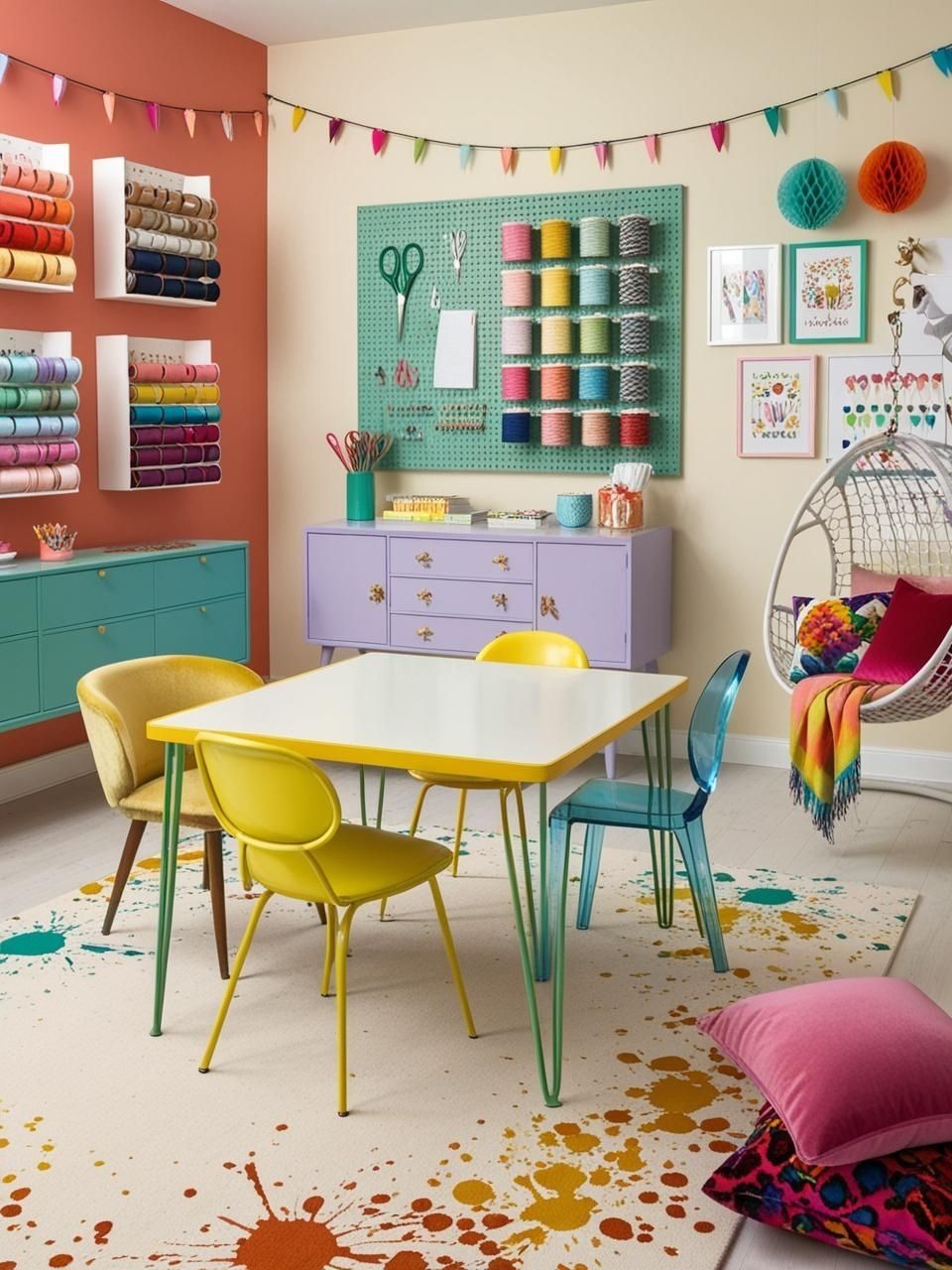
Step 4 – Embrace Nature with Plants & Organic Elements
Let’s have a heart-to-heart about that sad, neglected fiddle leaf fig you panic-bought after seeing it in literally every design magazine spread since 2015. It’s not your fault—we’ve all been victims of plant peer pressure. But here’s the tea: bringing nature indoors is about way more than ticking boxes on some trendy plant checklist.
The Houseplant Reality Check
Indoor plants aren’t just pretty green props—they’re legitimate mood-boosters grounded in science. But the dopamine hit disappears pretty quickly when you’re staring at a brown, crispy specimen that’s silently judging your caretaking abilities.
Here’s the truth bomb most plant influencers won’t drop: match the plant to your actual lifestyle, not your aspirational one.
- The serial plant killer: Snake plants, ZZ plants, and pothos will forgive your neglect (mostly)
- The well-intentioned but forgetful: Succulents and cacti are rolling their eyes at your watering schedule
- The helicopter plant parent: Go ahead, get that high-maintenance calathea—your obsessive attention is exactly what it craves
I once watched a client cycle through three monsteras in six months because they insisted on putting it in their dark hallway “because it looked good there.” We eventually compromised with a high-quality fake (gasp!) and saved both their wallet and the plant genocide. Sometimes design pragmatism trumps plant purism.
Beyond the Leaf: Organic Materials That Don’t Need Watering
Plants are just the gateway drug to a full-blown natural materials addiction. The real dopamine magic happens when you incorporate organic elements throughout your space:
- Wood with character: Forget those perfectly uniform pieces—look for grain, knots, and imperfections that tell a story
- Stone and clay: Cold materials that somehow make spaces feel warmer and more grounded
- Natural fibers: Jute, sisal, cotton, linen—textiles that breathe and age with character
The mistake most people make? Treating these elements as mere accents. That single wooden bowl on your coffee table isn’t fooling anyone. Go bold: a raw-edge wooden dining table, a chunky stone coffee table, clay pendants hanging over your kitchen island.
The Nature-Nurture Connection
Here’s the psychological nugget that explains why natural elements hit our dopamine receptors so hard: biophilia. Humans have an innate tendency to seek connections with nature. We spent millennia evolving outdoors, and our brains still crave those natural patterns and materials.
Some nature-inspired moves that deliver serious dopamine:
- Fractal patterns: Designs that mimic the mathematical patterns found in nature—think ferns, tree branches, river deltas
- Natural light manipulation: Sheer curtains that diffuse sunlight like forest canopy
- Sensory engagement: Materials that invite touch—rough stone, smooth wood, soft wool
The Indoor-Outdoor Blur
The most successful dopamine-boosting spaces don’t just contain natural elements—they actively blur the line between inside and outside. Glass doors that completely open to patios. Windows strategically placed to frame outdoor views like living art. Indoor plants that complement what’s growing outside.
I once worked with a basement apartment that felt like a dungeon despite the owner’s best efforts with lighting. The game-changer? We installed a small interior garden with grow lights and a water feature. The sound of trickling water transformed the psychological experience of the space completely.
Remember, dopamine decor isn’t about following rules—it’s about creating spaces that genuinely make you feel good. And few things trigger that primitive satisfaction quite like reconnecting with the natural world, even when you’re firmly planted on your couch scrolling through TikTok on your very unnatural smartphone.
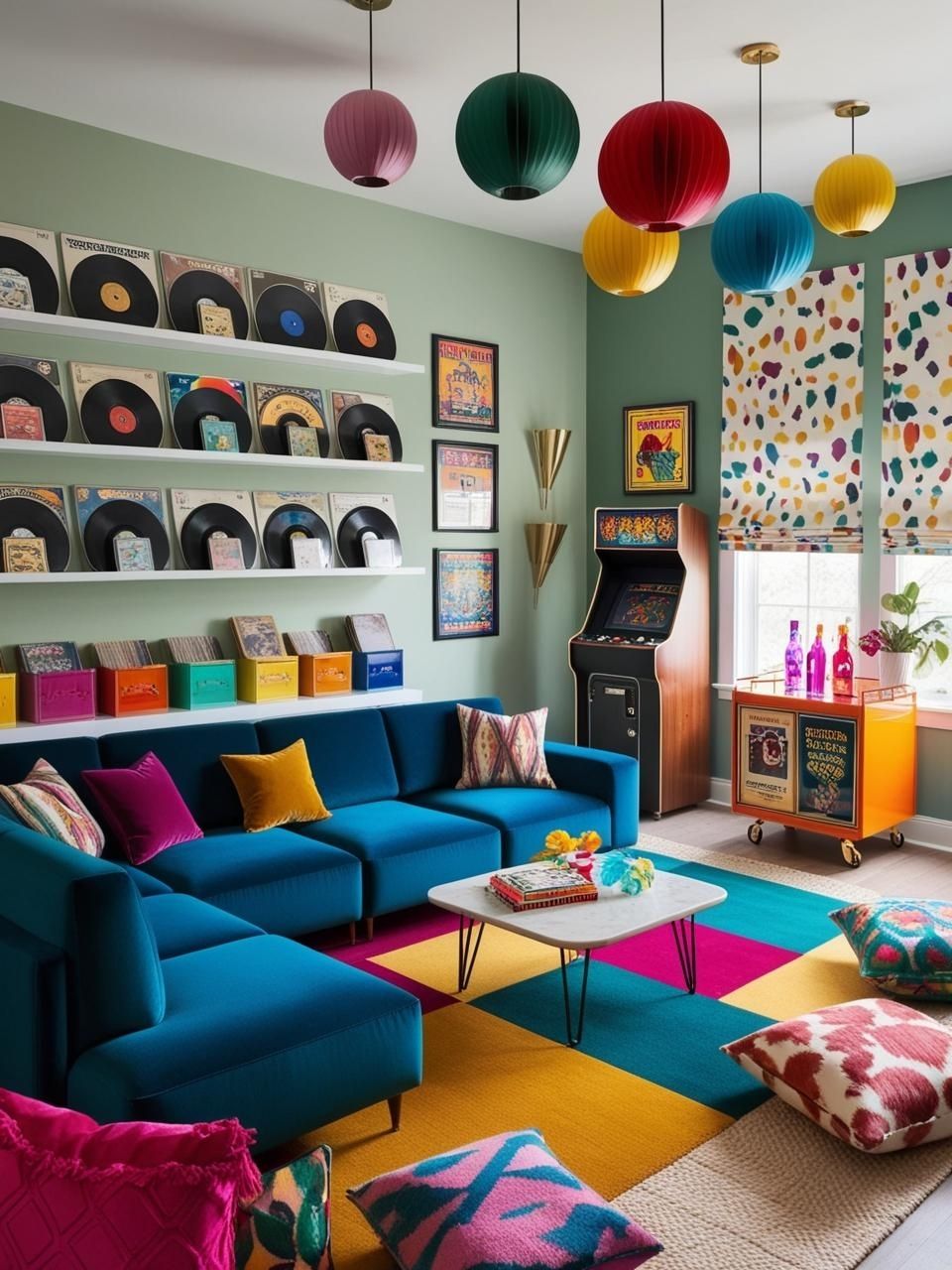
Step 5 – Play with Lighting to Create a Positive Ambiance
Let’s have an intervention about your lighting situation. Those sad overhead fixtures casting everyone in a morgue-worthy pallor? They’re actively sabotaging your dopamine levels. If your home lighting strategy consists of “flip switch, curse brightness, repeat,” we need to talk.
The Great Lighting Deception
Here’s the dirty secret that lighting designers don’t want you to know: expensive fixtures are only half the battle. You could drop thousands on that sculptural chandelier you’ve been eyeing on Instagram, but if you put the wrong bulb in it, your space will still feel like a depressing government office from 1983.
The dopamine difference comes down to three lighting factors that most people completely ignore:
- Color temperature: Measured in Kelvins, this determines whether your light feels like a cozy sunset (warm) or a soul-crushing hospital corridor (cool)
- Placement: The difference between “spotlight interrogation” and “you look fabulous in this light”
- Layering: The secret sauce that separates amateur from professional spaces
I once walked into someone’s living room where they’d invested in gorgeous designer lamps but filled them with harsh daylight bulbs because “they’re more energy efficient.” Yes, and so is sitting in the dark, but that doesn’t make it pleasant. We swapped in warm bulbs (2700-3000K for the lighting nerds out there), and suddenly their expensive furniture actually looked expensive.
Lighting Layers: The Holy Trinity
Think of lighting like a well-dressed person: you need base layers, mid-layers, and accent pieces to create a complete look.
- Ambient lighting: Your baseline illumination (ceiling fixtures, recessed lights)
- Task lighting: Functional light for specific activities (reading lamps, under-cabinet lighting)
- Accent lighting: The jewelry of your space (picture lights, uplighting on plants, LED strips)
The typical home has ambient lighting covered but completely neglects the other two layers. That’s like wearing only underwear and wondering why you don’t look put together.
The LED Revolution (Without Looking Like a Gaming Setup)
LED technology has transformed lighting into a dopamine playground, but with great power comes great responsibility. Not every space needs to look like the inside of a gaming PC.
Smart applications that actually boost mood:
- Color-changing bulbs in reading nooks: Blue-toned light for morning focus, amber tones for evening relaxation
- Light strips behind furniture: Creates depth without screaming “frat house party”
- Programmable schedules: Light that automatically shifts with your circadian rhythms
The key is subtlety. Your home shouldn’t look like it’s auditioning for a role in Blade Runner.
Natural Light: The Original Dopamine Dealer
All the fancy fixtures in the world can’t compete with good old-fashioned sunlight. If you’re blocking your windows with heavy drapes or bulky furniture, you’re essentially rejecting free dopamine.
The natural light makeover:
- Mirror placement: Position mirrors opposite windows to bounce light deeper into rooms
- Window treatment reconsideration: Are those blackout curtains really necessary in your living room?
- Reflective surfaces: Glossy finishes, metallic accents, and glass elements all amplify existing light
I once helped transform a notoriously dark apartment simply by replacing the owner’s heavy burgundy curtains with sheer white ones and adding a large mirror on the opposite wall. The space went from “depressing cave” to “airy retreat” without moving a single piece of furniture.
Remember, the goal of dopamine-inducing lighting isn’t to blind yourself with brightness—it’s to create an environment that supports different moods, activities, and times of day. Your space should feel as good at 7 PM as it does at noon, just in different ways. And if you’re still relying solely on that overhead fixture… well, we can’t be friends until you fix that. Sorry, I don’t make the rules.
Unlock Designer-Perfect Colors in Minutes
Browse my curated collection of interior color palettes—tailored for today’s most loved design styles.
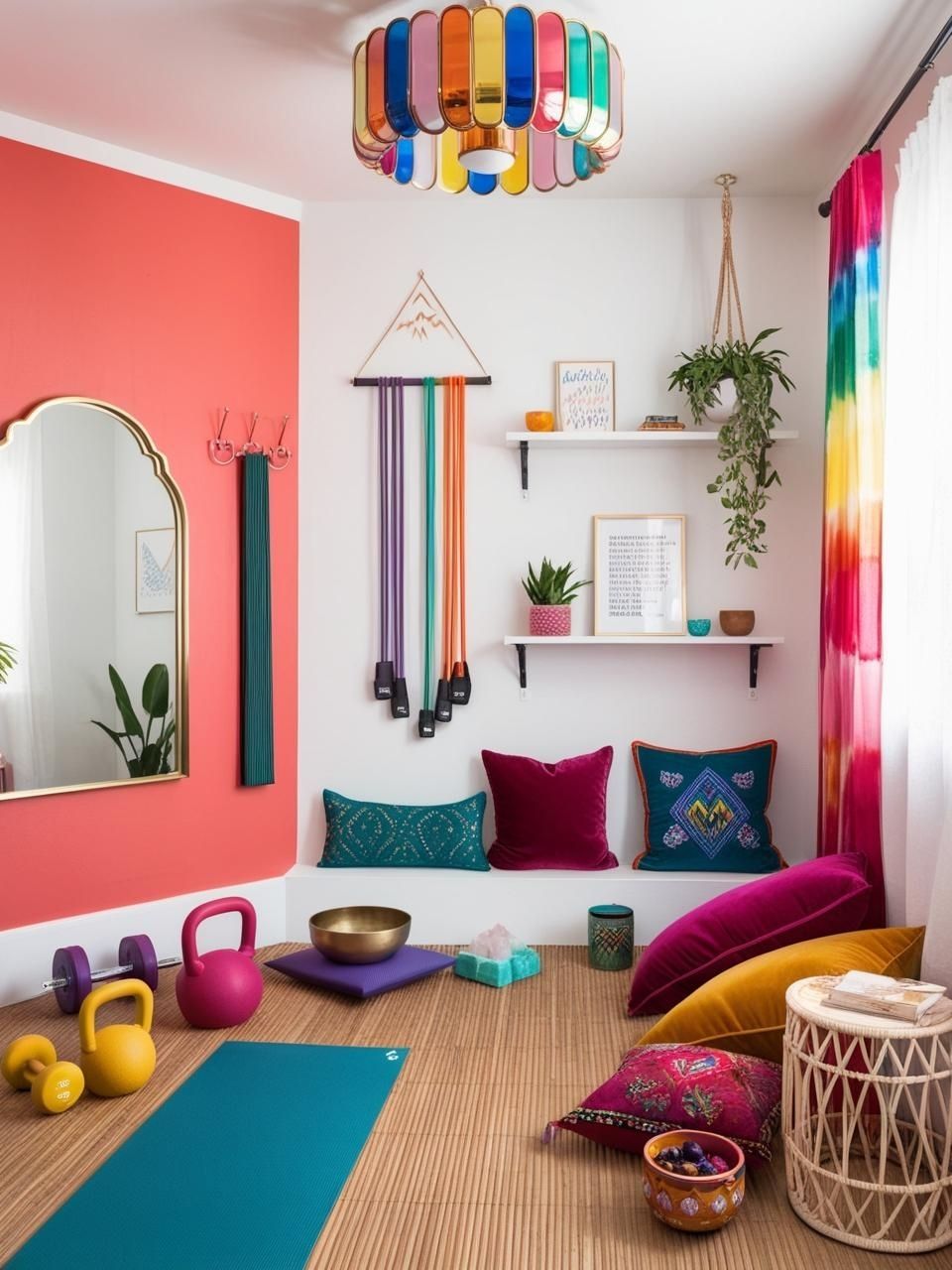
Step 6 – Use Quirky and Fun Decor Items
Alright, let’s cut straight to the chase: your sensible, grown-up furniture arrangement is crying out for something slightly ridiculous. That perfectly coordinated room? It needs a dash of visual mischief to wake up your brain. I’m talking about the decor equivalent of that friend who always brings tequila to book club—slightly disruptive, but ultimately what makes the gathering memorable.
The Anti-Boring Brigade
Let’s have an honest moment. Most spaces suffer from a severe case of Good Taste Syndrome—that affliction where everything is appropriate, coordinated, and utterly forgettable. Your brain craves novelty like it craves sugar, and quirky decor items are the visual dessert your space is desperately lacking.
I once walked into a client’s meticulously decorated living room—neutral tones, perfectly proportioned furniture, tasteful abstract art. It was lovely in the way that expensive hotel lobbies are lovely: designed to offend absolutely no one and excite absolutely no one. The fix? A vintage ceramic leopard lamp with a ridiculous fringe shade that her husband had banished to the basement years ago. That leopard became the room’s personality anchor, sparking conversations and making the space actually memorable.
Conversation Pieces That Don’t Try Too Hard
The key to quirky decor that hits the dopamine sweet spot:
- Authentic weirdness: Items you genuinely love, not “quirky” mass-produced signs that say “Live Laugh Love” in ironic typography
- Unexpected scale: Oversized art, undersized furniture—proportional surprises wake up the brain
- Functional whimsy: Unusual pieces that actually serve a purpose beyond collecting dust
The dopamine difference happens when quirky items feel like discovered treasures rather than calculated attempts at eccentricity. That vintage brass pineapple you found at a flea market? Dopamine gold. That mass-produced “quirky” ceramic pineapple from a big box store? Sad imposter.
The Fine Line Between Quirky and Chaotic
We’ve all been in spaces that went too far—where “eclectic” collapsed into “yard sale explosion.” The secret to quirky that doesn’t overwhelm? Deliberate restraint.
Try these approaches:
- The quirk concentration: One area of delightful visual chaos surrounded by relative calm
- The unexpected pairing: Traditional furniture + bizarre art, or vice versa
- The color discipline: Keep unusual pieces within a controlled palette to maintain cohesion
I once helped someone transform their dining room by hanging six different vintage serving trays on the wall—all completely different styles but painted the exact same shade of emerald green. It was wonderfully weird but still visually harmonious.
Beyond Objects: Architectural Quirk
Sometimes the most impactful quirky elements aren’t objects at all—they’re architectural details that challenge expectations:
- Unexpected paint moments: Ceiling painted darker than walls, doors in contrast colors
- Pattern bombs: Wallpaper in surprising locations (inside closets, on stair risers)
- Material juxtapositions: Sleek modern art hung on rough textured walls
Remember, dopamine decor is about creating spaces that make you feel something. A perfectly coordinated room might look nice in photos, but it’s often the slightly odd, unexpected elements that trigger genuine joy when you actually live with them. That weird sculpture your friend thinks is hideous but makes you smile every time you see it? That’s what we’re after.
Your space doesn’t need to make sense to anyone but you—it just needs to make you feel good. And sometimes that means embracing the slightly strange, the definitely quirky, and the absolutely unexpected. Your dopamine receptors will thank you.
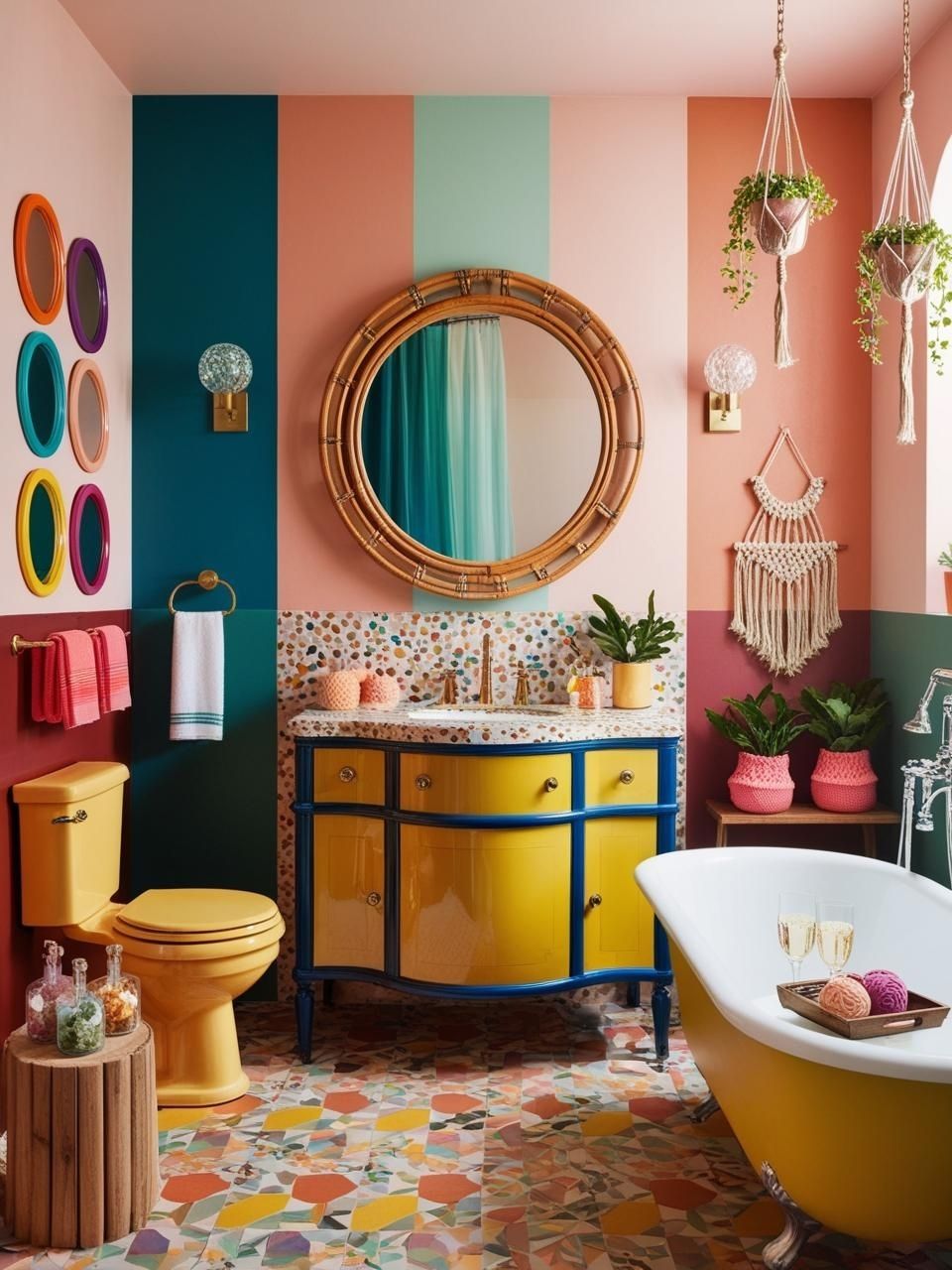
Step 7 – Create a Sense of Movement and Flow
Let’s talk about what nobody mentions in those perfectly staged design photos – how it actually feels to move through a space. Your home isn’t a museum diorama; it’s a living, breathing environment you navigate daily. And nothing kills dopamine faster than a room that feels static and stagnant.
The Static Space Trap
Here’s the uncomfortable truth: most people create rooms, not flows. They plop furniture against walls, center rugs under coffee tables, and call it a day. Congratulations, you’ve created the spatial equivalent of a stale cracker – technically edible, but nobody’s excited about it.
I once walked into a living room where everything was perfectly symmetrical – matching sofas facing each other across a rectangular coffee table, identical lamps standing at attention on twin end tables. It was like walking into a furniture showroom display that hadn’t been touched since 2003. The space was screaming for someone to disrupt its suffocating perfection.
The Flow Revolution
Creating movement isn’t about installing a lazy river through your living room (though that would be amazing). It’s about designing spaces that guide the eye and body naturally:
- Curved elements: Rounded furniture, circular rugs, and arched doorways create visual movement
- Asymmetrical arrangements: Slightly off-center placements that feel intentional, not accidental
- Varied heights: Mixing high and low elements to create visual rhythm (think tall plants next to low poufs)
The dopamine magic happens when your space feels dynamic even when nothing’s moving – like a still photograph that somehow captures energy.
The Anti-Feng Shui Approach (Sort Of)
Traditional feng shui has some great insights about flow, but here’s where we diverge: sometimes intentional interruption creates more interest than perfect harmony.
Try these disruptive flow techniques:
- The unexpected obstacle: A statement piece that forces you to move around it, making you more conscious of the space
- Visual surprises: Elements that aren’t visible until you’re inside the space, encouraging exploration
- Transitional moments: Deliberate shifts in flooring, ceiling height, or light levels between areas
I helped transform a predictable open-concept space by creating a partial divider with open shelving – not blocking the flow completely, but adding a moment of reveal as you move through. Every visitor commented on how the space felt more interesting, though they couldn’t always pinpoint why.
The Furniture Float
Here’s the most transformative movement trick that instantly separates amateur from professional spaces: float your furniture. I’m begging you.
The wall-hugging approach is the design equivalent of being that person at the party who never leaves the perimeter of the room. Float at least some pieces away from walls:
- Sofa positioned to create a pathway behind it
- Chairs angled toward each other rather than rigidly parallel
- Dining tables shifted slightly off-center in eating areas
I once convinced a skeptical client to pull their sofa just 18 inches away from the wall and angle it slightly toward their fireplace. That tiny adjustment completely transformed the energy of their living room from “waiting room” to “actual place humans want to gather.”
Remember, dopamine-triggering spaces aren’t static – they’re dynamic, even when nothing’s moving. Your home should feel like it’s mid-conversation, not frozen in an awkward pause. Create movement through intention, and your brain will reward you with that little hit of pleasure every time you navigate your space.
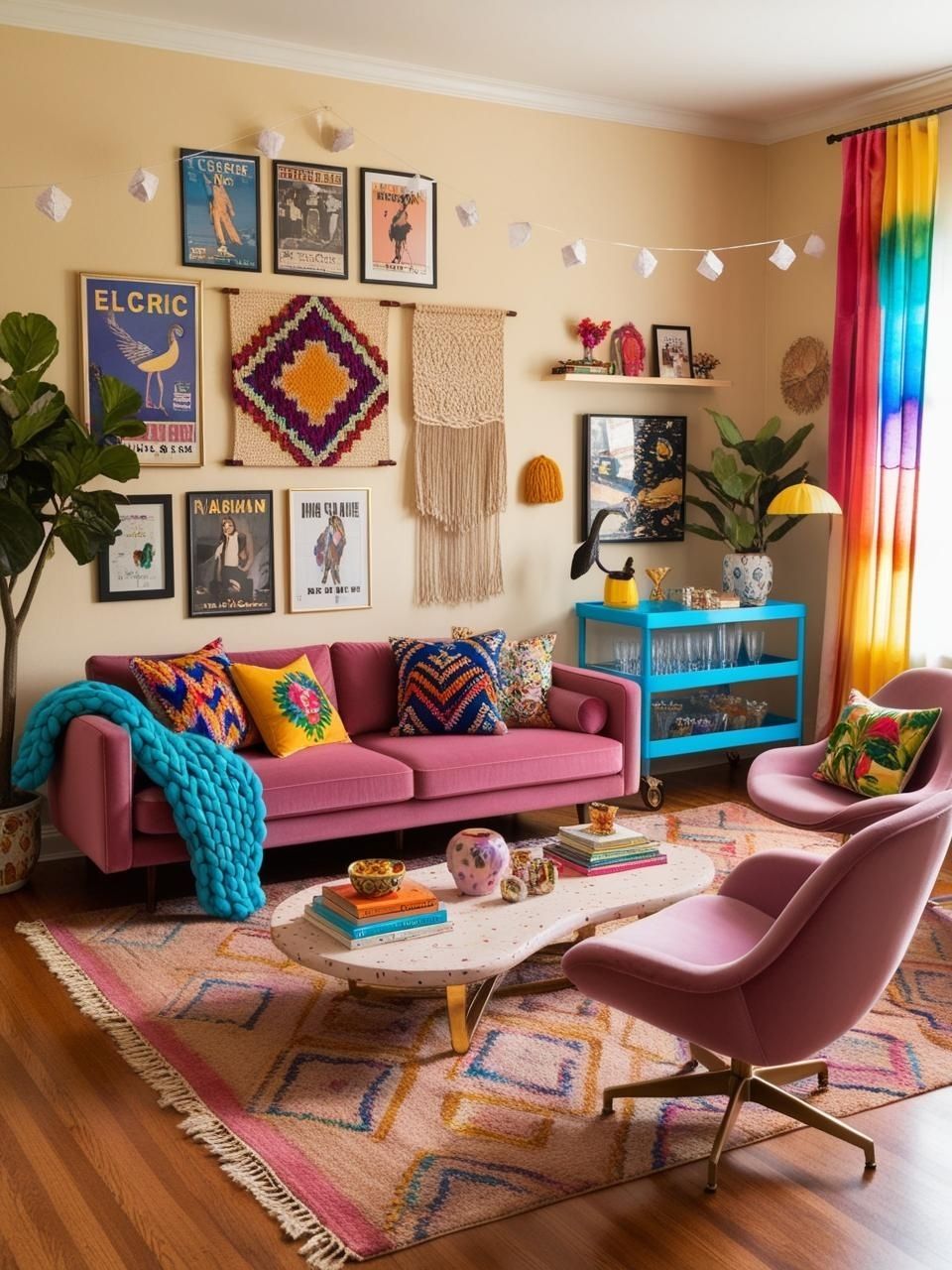
Step 8 – Personalize Your Space with Fun Features
Let’s be brutally honest about the state of your “personalized” space. If your idea of making a room your own is tossing a monogrammed throw pillow on the couch, we need to have a serious chat. True personalization isn’t about surface-level touches—it’s about creating features that make visitors say, “Well, this could literally only belong to you.”
The Custom Feature Reality Check
Most people’s idea of a custom feature is embarrassingly timid. You didn’t go through the trouble of having your own living space just to create a watered-down version of a hotel room, did you? I thought not.
I once walked into someone’s home where they had converted an entire wall into a massive magnetic poetry board using specialty paint. Every guest inevitably ended up creating little poems while conversations flowed. That’s the kind of personalization that delivers a dopamine jackpot—interactive, unexpected, and impossible to replicate from a catalog.
Beyond the Basic Gallery Wall
Listen, your framed diplomas and wedding photos are lovely, but they’re not exactly pushing any creative boundaries. Try these actually interesting approaches:
- The evolving installation: A wall or corner that regularly changes—seasonal collections, rotating art, or an analog “status update” of current obsessions
- The functional statement: A custom-built feature that reflects your passions while actually serving a purpose—like a rock climbing wall in a hallway (yes, I’ve seen it, and yes, it was glorious)
- The conversation catalyst: Something slightly controversial or question-provoking that prevents your gatherings from devolving into discussions about the weather
The dopamine difference happens when your space contains elements that couldn’t possibly exist anywhere else because they’re so specifically tied to your interests, history, or quirks.
The Sound & Movement Revolution
Your space isn’t just visual—it’s a full sensory experience. Yet most people completely ignore sound and movement when personalizing their homes.
Try these multi-sensory dopamine boosters:
- Ambient soundscapes: A small fountain that provides water sounds, wind chimes placed near frequently opened windows, or dedicated spaces for playing music
- Kinetic elements: Mobiles that move with air currents, light fixtures that create shifting patterns, or interactive art that changes with touch
I helped someone transform a standard dining area by hanging a collection of small musical instruments on the wall nearby. Dinner conversations regularly paused for impromptu (terrible) musical interludes, and the space became known among their friends as the most entertaining place to gather.
The Permission Slip You Needed
Here’s your official permission to stop creating spaces that look like they’re auditioning for an Airbnb listing. Your home doesn’t need to appeal to hypothetical future buyers or impress your judgment-prone in-laws. It needs to make YOU feel something.
Some truly personalized spaces I’ve seen that delivered major dopamine:
- A ceiling painted to look like a star map showing the night sky on the owner’s birthday
- A kitchen with cabinet knobs collected from different countries during travels
- A hallway with floor tiles that incorporated tiny fossils the owner had collected as a geology student
The point is, these spaces couldn’t be replicated or mass-produced because they were deeply personal to the people living in them.
Remember, your home isn’t a neutral container for your life—it’s an active participant in it. When you infuse it with features that truly reflect your passions, interests, and history, you create an environment that continually feeds your dopamine receptors. And seriously, that’s way more valuable than worrying about whether your throw pillows coordinate with your rug.
Curated Wall Art for Elegant Homes
Bring softness, texture, and intention into your home with digital wall art inspired by wabi-sabi, abstract forms, and muted watercolors. Every piece is crafted to create stillness and beauty—whether you’re styling a gallery wall or a minimalist nook.
Conclusion
Let’s wrap up this dopamine decor journey with some real talk: creating a joy-filled home isn’t about following some color-by-numbers approach to happiness. Those perfectly curated “dopamine decor” reels on social media? They’re about as authentic as those “I woke up like this” selfies with full makeup.
The truth about dopamine-boosting spaces is deliciously simple and incredibly personal. Your brain doesn’t get a happiness hit from following trends – it lights up when you create an environment that feels authentically, unapologetically you.
Remember these dopamine design truths:
- Your color choices should reflect what makes YOU smile, not what some color psychology chart dictates
- Patterns and textures should invite touch and engagement, not just look pretty in photos
- Personal items become powerful when curated with intention, not when they overwhelm your space
- Natural elements connect us to something primal and essential, regardless of what’s trending
- Lighting shapes emotion more than any expensive furniture ever could
- Quirky elements create the personality that turns a house into a home
- Movement and flow determine how you experience your space in three dimensions
- Personalized features make your space impossible to replicate – and that’s exactly the point
I’ve seen million-dollar homes that feel like emotional deserts and modest apartments bursting with joy. The difference isn’t budget – it’s intention. The most successful dopamine-filled spaces are created by people who have the courage to ask “Does this actually make me happy?” rather than “Will this look good on Instagram?”
So go ahead – paint that accent wall in the color that reminds you of your favorite childhood vacation, not the color that’s trending this season. Display that weird souvenir that makes you smile even though your minimalist friend thinks it’s clutter. Create a space that feels like a full-body yes rather than a reluctant shrug.
Because ultimately, dopamine decor isn’t about following rules – it’s about breaking free from them to create a space that feels like your own personal happiness headquarters. And there’s nothing more dopamine-inducing than that.